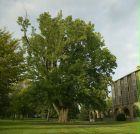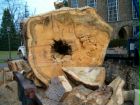By Sidney Wertimer, professor of economics, emeritus
Editor's Note: The campus lost one of its oldest and most majestic inhabitants in November when the cucumber magnolia tree that towered in front of the Bristol Center was removed. Once Hamilton's largest tree in diameter and a New York State champion specimen, the tree was hollow and in danger of falling. In tribute to this fallen giant, Sidney Wertimer, professor of economics, emeritus, wrote a reflection of trees at Hamilton.
The first time I remember being intellectually interested in trees was during a visit to Professor Ralph C. Epstein's country farm outside of Buffalo. He was chairman of the economics department at the University of Buffalo and had hired me in the fall of 1946 as an instructor. Ellie and I were invited out to "More-or-Less" farm (the deed to the property, he said, was "for 20 [?] acres, more or less") for a day and dinner. During our visit, he pointed out his favorite tree off in a field — a Nyssa sylvatica, which, he said, "liked wet feet." Its other more common names are Sour Gum and Tupelo. He went on to name a number of other trees by their botanical names, and I became intrigued.
When we came to Hamilton in 1952, the number and variety of trees on campus impressed me. With the help of Walter Hess, professor of biology, I began to sketch out a plot of the trees in the main quad. Shortly thereafter, we got to know Grace Root and my interest in trees grew even further. She was delighted and showed me the rather detailed map of the campus trees that her late husband, Edward Root, had drawn. When we built our house in 1956, she invited me to harvest any trees or shrubs from her glen for our property. There were, at the time, only three trees on our property — a decaying apple and two magnificent sugar maples. I transplanted two Judas bushes, two hemlocks, two yellow woods and a tulip tree which callipered an inch and a half. Both Judas bushes have survived, but we have lost the apple, one of the hemlocks and one of the yellow woods. The tulip tree now calipers 24 inches, and the yellow wood is the finest specimen on the Hill, but the biggest maple is decaying and being removed limb by limb.
Senator Elihu Root (also secretary of war and state, and justice on the World Court), when he was chairman of our board of trustees (1909-1937), took a great interest in the grounds. He had a great row of white pine and Norway spruce trees planted just west of Miller Road to demark the western edge of the campus ("so no one could look down on Hamilton") and a row of mugo pines east of that road. The pines were allowed to grow, eventually obscuring the view of campus and were removed in the mid-1990s.
When we first came, College Hill Road was lined on the north side by a number of rather old Lombardy Poplars (Populus nigra Italica). The superintendent of physical plant at the time, Jack Letzelter (energetic but casually informed about things horticultural) had them removed as they began to die off. There was also a row of those poplars along the west road of the central quadrangle extending from Carnegie dormitory to the front of the Soper Commons. They were in bad shape, too. One snowy day they were all cut down and hauled away. This was understood to be inevitable, and not much notice was taken. In the following late spring, sycamores were planted where the poplars had stood. President McEwen summoned the superintendent to find out what was going on. Mr. Letzelter replied that he had been reading up on trees and he liked the bark on the sycamores, so he chose to plant them. Mr. McEwen phoned Frederick Lee, a trustee who was knowledgeable botanically, and they agreed to let the superintendent proceed. That is why we have London Plane trees (Platanus acerifolia) on the middle quadrangle. (1958?)
There used to be a road in front of the Sigma Phi fraternity house and just in front of the plinth reminding us of Professor Peters' observatory. At the corner of that road and Campus Road stood a medium-sized Buckeye (Aesculus pavia) with drooping limbs. For some reason it was, I think, a favorite of Edward Root. It is related to the Horse Chestnut (Aesculus hippocastanum) and produces bright red panicles when in bloom. (The horse chestnut produces a white bloom.) At some point, the grounds crew pointed out that it was hard to mow the grass under it, so Mr. Letzelter had the tree "lifted" — all of its lower branches were cut off to clear the ground by about three feet. When he discovered it, Mr. Root went to Mr. Letzelter's office to object in what we are led to believe were explicit and caustic if not violent terms. Mr. Letzelter got the message. Mr. Root, however, recovered from his rage and, being the gentleman he was, wrote a note of apology for the excess of his expression. (1954?)
Several years later, on our return from summer vacation, I was appalled to see that the Camperdown Elm (Ulmus glabra camperdownii) that is located on the east side of the Hill just below the turnoff to Campus Road had also been "lifted." I have no idea how this came about, given the experience with the buckeye (Mr. Root had by this time died), but I did chide Mr. Letzelter for it. So far as I know, it has not been tampered with since despite the inconvenience to those who mow the lawn beneath it. (1960?) Another Camperdown used to grow behind Minor Theater where a love scene for The Sterile Cuckoo was filmed. It has since disappeared.
The last vestige of an American Chestnut (Castanea dentate) tree grew behind Grace's "glen house." It lasted several years following her move to the home, but finally one summer the leaves withered and the small tree died. (1963?)
There are a couple of trees on campus of special note. The Ginkgo (Ginkgo biloba) in front of the Admission Office is one of three big specimens in the area. Another is located on the north side of College Street in the village, and the third is in the vast parking lot in front of what is now the Dollar General store. The latter was "saved" by Grace Root when the parking lot was established at the same time the Great American store was built in the late 1960s. Its removal was proposed, but Grace importuned the "town fathers" not to let it be cut down as a condition of establishing the store and parking lot. These ginkgos turn a bright yellow in the fall, and drop their leaves all in one day.
The other tree of special note is a "sport." It is a Bald Cypress (Taxodium distichum) of large dimensions that grows behind the Bristol Center. It is usually a native of southern swamps where it grows in profusion and produces "knees" which stick out of the water at the base of the trunk. It is also unusual in that it is a deciduous conifer (like the Tamarack, of which there are several species on campus). How it came to live on our campus is a mystery.
When it was decided to erect a student center on the east campus, the site chosen balanced that proposed building symmetrically with the south entrance to Dunham Residence Hall, using a centerline of the late Truax Hall on the north and Benedict Hall on the south. This would mean cutting down a large, mature magnolia tree in front of the proposed building. The location of the building created quite a stir among the students, by Grace Root, and by General Ulysses S. Grant III, his wife and her two sisters who inhabited the Root summer house (now the Admission Office). At the end of the academic year, Grace had persuaded the editor of the Spectator to publish an extra edition of the paper, the chief purpose of which was to protest the location of the campus center that endangered that Magnolia acuminata. President McEwen was upset by this and invited me to walk with him through the woods south of the campus to inquire about the source of funding for the extra edition of the paper, which I knew. He then asked Grant Keehn, then chairman of the board, to come up to make the final decision about the campus center's location. Mr. Letzelter had driven stakes into the ground to show the proposed location that would eliminate the tree. I was able to point out that the symmetry idea was acceptable if one was making observations from up in the air. Mr. Keehn approved moving the location 50 feet to the east. (1966?) That lovely tree, alas, has now reached post maturity, is badly weakened by rot and represents a hazard. It is scheduled, after 40 years of safety, to be removed.
As a further gesture of protest, however, General Grant, his wife and sisters planted three trees (a white pine, a hemlock and a Norway maple) in the middle of their front lawn to obscure the view of the new campus center. Those trees — and the campus center — still stand. (1967?)
During my years (1975-80) as provost of the College (and indeed before), there appeared a melancholy item in the physical plant budgets for the removal of dead American Elms (Ulmus Americana). During those years, about a hundred of these magnificent tall trees with few lower branches died of the Dutch elm disease and had to be removed. We have searched for a new strain of blight-resistant elms, and several have been planted at the Bristol Center and on the west lawn near Commons. (1994-96)
President Carovano had a great interest and knowledge of trees, and early in his administration, he engaged Thomas Succop '58, a skilled landscape architect, to consult on our plantings. Each year, Tom would make suggestions about landscaping an area of campus, starting with the center quadrangle. He soon found out about my affection for the tupelo, and when I retired from being provost, he had the buildings and grounds crew plant three of them (1981) in the area between the Kirner Johnson building and Babbitt Residence Hall overlooking my new office. Prior to this, I had Parker Scripture, a local horticulturist, plant one in the southwest corner of the area in front of Dunham (1966). Another was planted in front of Buttrick Hall on the main quad (1986) by the College horticulturalist (who tells me that it appears in the records as the "Wertimer Tupelo"). These trees are great crimson ornaments in the fall.
There are, from time to time, suggestions made to "raise" the lower branches of some of our campus trees to better observe the architecture of the buildings. Visitors to the campus make these well-intentioned suggestions usually during the fully leafed-out season. Those of us who live here 12 months of the year are able to revel in the architectural delights of the buildings for a good six or seven months. There is a good deal to be said to let trees generate their inherent shapes, and not interfere with their natural growth.
Led by Tom Succop, Hamilton has now established an arboretum on campus, which will be overseen by our skilled and knowledgeable College horticulturist Terry Hawkridge. This means that in the future, greater attention will be paid to the variety and location of our various horticultural specimens all across our 1,300 acres.
| The Cucumber Magnolia as it looked last summer. |
The Cucumber Magnolia's trunk showing decay above the hollow. |
Posted January 5, 2005


